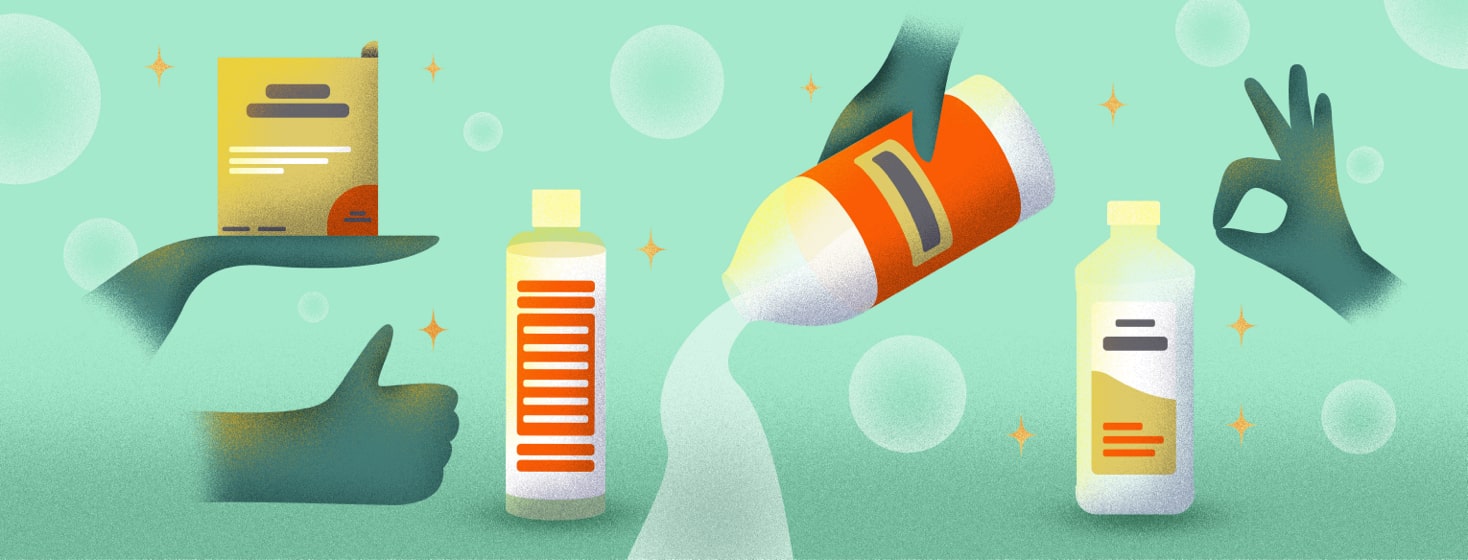Non-Toxic Cleaning for Hidradenitis Suppurativa (Part 1)
I am huffing and puffing and wiping some dew drops off of my brow. Now it’s time for a water break. Okay, I’m just 30 minutes in, but I know I have more to go. It’s better not to look at the clock or I will get really – and I mean REALLY – discouraged, and I will just be tempted to plop down on the couch and continue a favorite series on my TV. No, I know I have friends that will be walking through my door in about 15 hours, so I have to be serious about cleaning.
But I’m serious about cleaning without ready-made chemicals while also saving money. Besides trying to clean up my diet for my hidradenitis suppurativa, I’m also cleaning up my household without heavy chemicals. Reactions to chemicals can lead to inflammation in the body, which is what I want to avoid just because of the nature of hidradenitis suppurativa.
A disclaimer: any brands mentioned in this article are for the sake of explanation in this article. I don’t receive any type of compensation or reward.
Starting with the basics
I’m going to start with basics, as I keep these items stocked in my house at all times. I use these ingredients daily to help me clean. They are so inexpensive, and so easy. I just don’t go down the chemical aisle unless I need dish soap (and I use Seventh Generation, which is low or no perfume and within my budget). Please note that I am not going to include bleach, as that is considered a harsh and harmful chemical when it comes into contact with bare skin and lungs when undiluted, and I am also personally allergic to it.
Vinegar
First on my list is vinegar. Vinegar is antimicrobial, meaning it is not friendly to microbes. It’s why back in the times when refrigeration wasn’t common (think covered wagons and before), pickling was heavily utilized. Pickled pigs’ feet? What a hit! Pickled beets? What a treat! So I hope this helps everyone to understand that this fights both bacteria and mold, and if it’s used in our environment, it’s very helpful.
I know a lot of people use apple cider vinegar, but holy moly, that gets expensive! I just use regular white distilled vinegar. I don’t get fancy.
Isopropyl alcohol
Second is 70% isopropyl alcohol. Isopropyl alcohol is also incredibly effective at killing microbes, including bacteria, viruses and fungi. If you go to a dollar store, they only have concentrations of 50%, and I strongly advise against that strength - it just doesn’t cut it. 70% is the most effective, not a higher percentage. There is a really good explanation for this, but it has to do with time lapse and how the walls of the microbes are denatured. 91% goes too fast and it all globs together, so the alcohol can’t penetrate and kill everything; 70% is just right. The only thing that it doesn’t kill is mold spores. So just like everything else sold off the store shelves to the general public (Lysol comes to mind), you’re going to get the same effect.
Baking soda
Baking soda is great for baking, but it is also great for scrubbing! If you belong to a club store like Costco or Sam’s Club, you can purchase a 13-lb. bag for under $10. It is taking me a long time to go through my most recent bag. I feel like elves come and restock mine when I’m sleeping, because it never seems to go down after I use it.
Dr. Bronner's castile soap
I’m a huge fan of Dr. Bronner’s 18-in-1 liquid castile soaps. This started about 28 years ago when I was on a road trip, and my friend and I were camping across the U.S., and the space in my car was precious. I needed soap to wash dishes, but also to wash my body. The original creator of Dr. Bronner’s wrote all kinds of messages on the label, including the different usages for the liquid soap, which was only peppermint scented back then. The label was excited to tell everyone that it could be used to wash your dishes, your clothes, you teeth, your body, you hair, your face... well, you get the idea. I have to admit that I could never make it over the hurdle of using it for my teeth, but my friend did. But for the sake of this article, I would like to suggest keeping a bottle for its many uses. I like the original peppermint, but also love the citrus or almond flavors too. I suggested the unscented option for my mom when she was reacting to scents when cleaning out her CPAP equipment, and all of her reactions went away.
Some products I avoid
I understand that some people are big fans of using peroxide or even vodka to clean. First, I don’t use peroxide in any of my cleaning because what I use already does a fantastic job. I get all of the anti-microbial action I need and everything is as debugged as I need it to be. Second, mixing peroxide with vinegar or peroxide with isopropyl alcohol results in extremely toxic acidic compounds and can lead to emergency situations. I’m trying to heal my body, not hurt it! As far as vodka goes, it’s far less expensive to buy a gallon of vinegar than it is to buy a gallon of vodka. Plus I don’t know how many times I could say, “It’s for cleaning!” when I’m leaving the store, lugging a gallon of vodka.
Stay tuned for Part 2 where I review how I put these ingredients together to keep my environment clean.

Join the conversation